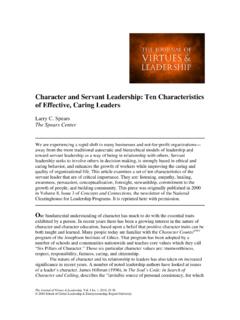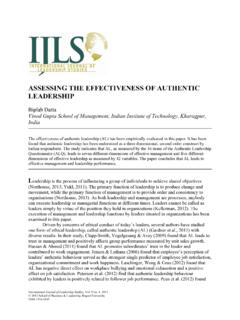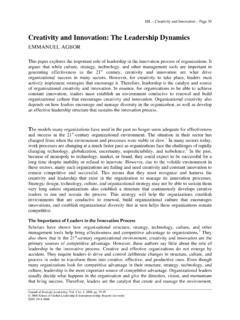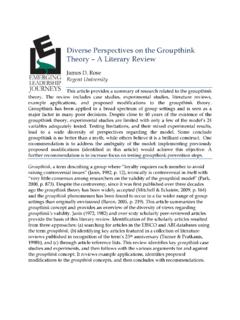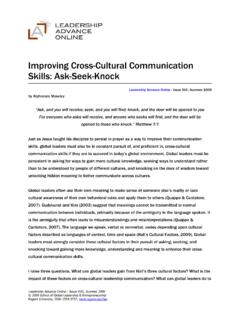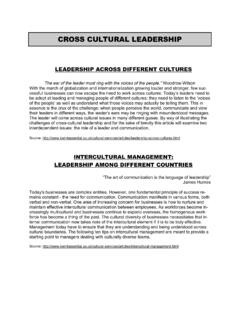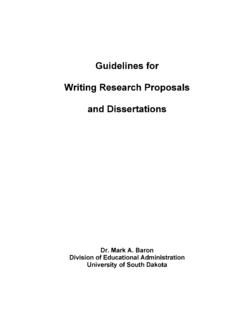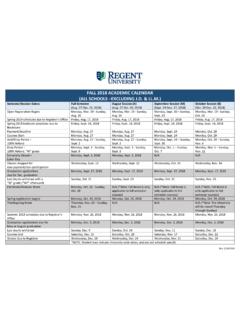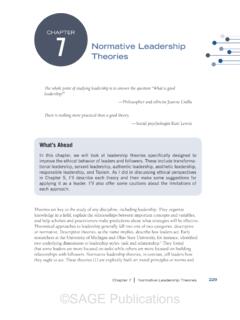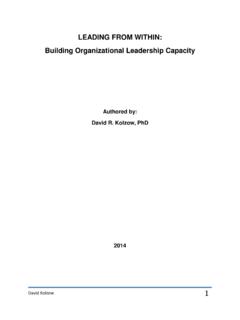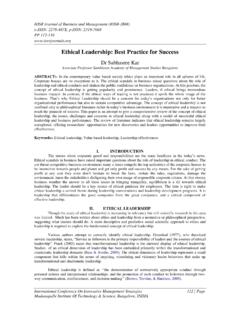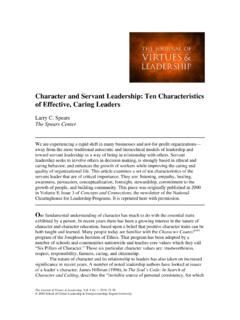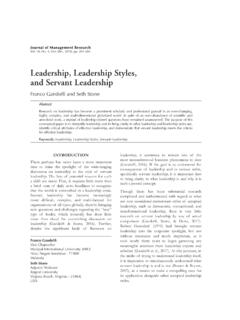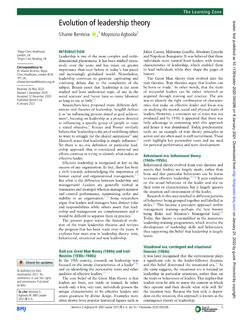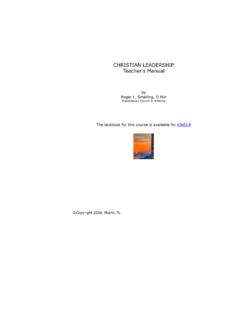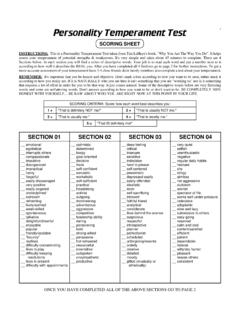Transcription of A Review of the Literature Concerning Ethical Leadership ...
1 A Review of the Literature Concerning Ethical Leadership in Organizations Kelly Monahan Regent University The following article explores the Literature regarding the topic of Ethical Leadership . Thirty-eight articles were identified that are written by authors who focused on four main topics. These topics are the definition of Ethical Leadership , the personal integrity and morality of a leader, how a leader ethically influences followers, and current challenges facing Ethical leaders. These four topics are explored in further detail within the Literature Review . Overall, it is found that Ethical Leadership is complex and a relatively newer field of study. Yet, common themes include the need for establishing trust and gaining Ethical knowledge by way of study and application. Also, major organizational failures, such as Enron, have ignited an interest within the field.
2 Possible further research is recommended at the end of this Review . T. his article examines the Literature regarding the topic of Ethical Leadership within organizations. The Literature Review was conducted by utilizing databases such as , the Library of Congress database, Academic Search Complete, EBSCO host Discovery, and OmniFile Full-Text Mega. Additional resources were secured at Barnes and Nobles bookstore. A list of keywords used during the search is Ethical Leadership , ethics, morality, virtues, values, morals, and management. Thirty-eight articles were ultimately selected due to their focus on four main topics: a). defining Ethical Leadership , b) the personal integrity of the leader, c) influencing followers in ethics, and d) current challenges and solutions. The structure of the Literature Review examines each of these four topics in greater depth and considers the findings in the end.
3 Defining Ethical Leadership The study of Ethical Leadership is increasing in relevancy, as once famed organizations have fallen from grace. In recent years, one has been exposed to the collapse of Enron, the fall of the Lehman Brothers, as well as the housing market crash; all due, in part, to unethical behavior. Green and Odom (2003) note that the lack of Ethical Leadership in Enron caused harm to thousands of employees, invoked greater government regulation, and crippled consumer confidence of the financial industry (Thompson, 2010). Emerging Leadership Journeys, Vol. 5 Iss. 1, pp. 56-66. 2012 Regent University School of Global Leadership & Entrepreneurship ISSN 1941-4684 | A Review of the Literature Concerning Ethical Leadership in Organizations P a g e | 57. The examples of organizations exhibiting unethical behavior has caused businesses to reexamine their strategic direction, helping them learn that Ethical Leadership is the way which leads to profitability (Moss, 2002).
4 However, as Thornton (2009) notes, Now in the global marketplace, with fierce competition for business and resources, the scope of problems that can occur in Leadership ethics has expanded exponentially (p. 60). As a result of the increasing scope of concerns within today's organizations, it is noted that one of the greatest needs is a charismatic Ethical leader (Mackie, Taylor, Finegold, Darr, & Singer, 2006). A rigorous qualitative study completed by Plinio, Young, and Lavery (2010) found that one of the most serious problem facing organizations today is impoverished Ethical behavior and nonexistent Ethical Leadership . Consequently, the authors note that trust in Leadership is waning and the situation is worsened by a weak economy. The authors also noted an alarming increase in misconduct by employees at all levels.
5 Darcy (2010) confirms that the current climate of organizations is skeptical regarding ethics. In a qualitative study completed by the author, it was discovered that sixty-six per cent of people question if ethics within Leadership even exists. This is what the author refers to as a crisis of trust (p. 200). The conclusion of the study found that the biggest problem in organizations and individuals today is a lack of trust. This lack of trust can be attributed to what Frank (2002) calls the shadow side of Leadership . These shadows include the negative influences of power, privilege, deception, inconsistency, irresponsibility, and misplaced loyalties (p. 81). Unfortunately, over time followers become exposed to the consequences these shadow behaviors cause, and lose trust in the integrity of their leader.
6 This has ignited a slew of research and articles regarding the topic of Ethical Leadership . How does one lead a company in an Ethical manner while also producing a plethora of profits? In order to answer this question, one must first gain an understanding of what the Literature defines as Ethical Leadership . Yukl (2006) summarizes the Ethical leader as one who promotes honesty, and mirrors his or her actions with their values and beliefs. However, the author acknowledges the field of Ethical Leadership is an ambiguous construct, which includes various constituents. As a result, Ethical Leadership may be difficult to evaluate. Executives at large organizations define Ethical Leadership as simply a matter of leaders having good character and the right values or being a person of strong character (Freeman & Stewart, 2006, p.)
7 2). Executives admit that following the law and obeying regulations are not what makes ethics complicated. They even disclose that influencing others to do the right thing is not the problematical part of Ethical Leadership . Rather, the complexity of Ethical Leadership exists in the gray areas of who is responsible when problems arise (Plinio, 2009). Emerging Leadership Journeys, Vol. 5 Iss. 1, pp. 56-66. 2012 Regent University School of Global Leadership & Entrepreneurship ISSN 1941-4684 | A Review of the Literature Concerning Ethical Leadership in Organizations P a g e | 58. Nevertheless, various authors attempt to correctly identify Ethical Leadership . Greenleaf (1977), who theorized servant Leadership , states, Service to followers is the primary responsibility of leaders and the essence of Ethical Leadership (p.
8 20). Heifetz (2006). proposes that the primary responsibility of Ethical leaders is to deal with conflict among followers, and instruct them in the right way. Frank (2002) states that transformational Leadership is the outward display of Ethical Leadership . Though slightly different definitions have been constructed, all of these authors agree that Ethical Leadership is focused on influencing followers to do the right thing. In contrast, Cumbo (2009) focuses on the leader when defining Ethical Leadership . A. leader is considered Ethical when inward virtues direct the leader's decision-making process. Followers simply are beneficiaries of a leader living a virtuous life. A leader is motivated not by influencing others but rather living by one's own virtues. The author states that virtues are amplified when the leader exhibits imagination, compassion, empathy, and discernment (p.
9 726). Martinez-Saenz (2009) identifies constructs within Ethical Leadership . Five paradigms identified are altruistic, egoistic, autonomous, legalist, and communitarian. One of these constructs is not favored over another, but rather the authors identify various examples and environments for each. Altruistic motivation within Ethical Leadership is the leader acting out of selfless motives. Egoistic is when the right thing is considered by leaders because of a selfish motive. Autonomous is allowing followers to determine their own direction of ethics. The authors define legalist ethics as leaders following a set of given rules or regulations. Communitarian, on the other hand, places the emphasis on bettering society and the community in which the organization resides. Plinio (2009) reviewed three commonly correlated Leadership theories to Ethical Leadership .
10 The first classical Leadership theory that associates with Ethical Leadership is transforming Leadership . Transforming Leadership ultimately becomes moral in that it raises the level of human conduct and Ethical aspiration of both leader and led, and thus it has a transforming effect on both (Burns, 1978, p. 134). The second is servant Leadership , which emphasizes the need to serve followers and devote oneself to the Ethical development of followers. The third classical Leadership theory is authentic Leadership . Plinio (2009) states that the very essence of ethics is being true to oneself and authentic. Sandel (2009) notes three common historical approaches to Ethical Leadership . The first approach is the leader maximizing the welfare of followers as defined by Utilitarianism Theory. The second is a leader protecting the freedom of individuals, which is noted in Libertarianism Theory.
